Growing Microgreens Using the Kratky Method: A Comprehensive Guide
In today’s world, where health and nutrition are increasingly prioritized, microgreens stand out as nutrient-rich, flavorful little greens. Although many enjoy the process of growing and caring for their plants, it can be somewhat time-consuming, and it's easy to overlook watering them, especially for those with busy schedules.
Additionally, some individuals prefer a more laid-back approach to gardening. While automated hydroponic systems such as NFT channels or Flood and Drain tables are options, they often require significant space, may produce more microgreens or veggies than what some need, and can be somewhat expensive to set up. This is where the Kratky method, a passive hydroponic system, offers a simple and efficient way to cultivate nutritious plants at home.
Understanding the Kratky Method
For those new to the concept, the Kratky method is a hydroponic technique pioneered by Dr. Bernard A. Kratky at the University of Hawaii. This method involves growing plants suspended over a nutrient-filled water reservoir. Unlike the deep water culture (DWC) method, the Kratky method operates without electricity, negating the need for pumps and airstones. This characteristic simplifies the process, making it an excellent choice for novices or anyone looking for a low-maintenance gardening solution.
In hydroponic farming, the Kratky method is typically used for mature crops such as tomatoes, peppers, and cannabis. However, these crops, with their longer growth cycles, are more prone to root rot due to the lack of water aeration, unless the reservoir is maintained properly.

The advantage of microgreens is their short growth cycle, typically ranging from 7 to 14 days, with the initial 3-5 days dedicated to germination for most varieties. This means the roots of the microgreens will only be suspended above the nutrient-rich water for about 4 to 8 days when using the Kratky method that we are going to share with you in this blog. And because we're utilizing a scaled-down system for microgreens, the risk of encountering root rot, common in mature crops, is significantly reduced.
The Benefits of Using the Kratky Method for Microgreens
The primary advantage of using the Kratky method for microgreens lies in its largely hands-off approach to cultivation. As mentioned in the last paragraph, the initial 3 to 5 days (for most crops) is the germination phase, followed by a 4 to 8 day period (for most crops) utilizing the Kratky method. Essentially, your involvement is required during the germination phase (the first 3 to 5 days), and once the seedlings are ready for light exposure, you simply fill the reservoir tray and ensure the roots are in contact with the water. From there, you're looking at a roughly 4 to 8 day stretch where your main task is merely to monitor their growth. This approach conveniently allows for a minimal 2-day break, which can be wonderful for a weekend camping trip, or even an overnight trip somewhere with proper planning and timing. That, and it's a really affordable system, that takes very little supplies & knowledge to make.
Essential Equipment for Kratky Method Microgreens Cultivation
- A single 1-inch deep tray without holes, to maintain humidity.
- A single 1-inch deep mesh tray, for planting.
- A single 2-inch deep tray without holes, serving as the Kratky method reservoir. It's crucial for the planting tray to be shallow and the reservoir tray to be deeper to ensure a proper setup, allowing plants to hang above the water effectively. Otherwise, the system won’t function properly.
Additional Requirements:
- Growing medium (options include our silicone reusable grow medium, coco coir, or vermiculite).
- Hydroponic nutrient solution.
- Premium microgreen seeds.
- A light source, either natural or artificial.
The setup we’ll discuss in this blog, which is also featured in our YouTube videos and social media, is our user-friendly 10x20 Kratky Hydroponics Tray Kit available on our website.
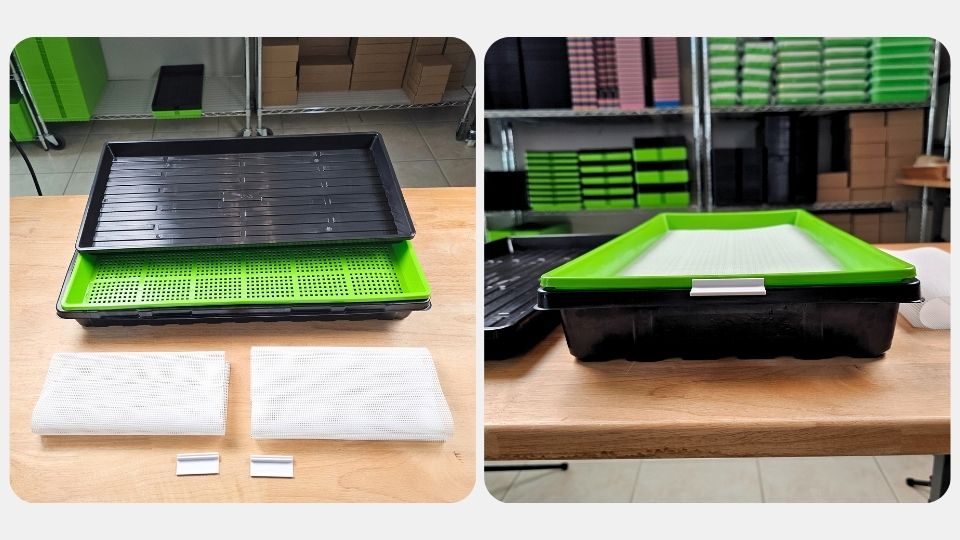
This kit includes all three necessary 10x20 trays, two of our silicone reusable grow mediums, and two tray clip labelers, providing a complete Kratky System setup for growing microgreens. While this kit offers convenience, individual components are also available for purchase, either through us or other suppliers.
How to grow Microgreens using the Kratky Method
Seeding & Germination
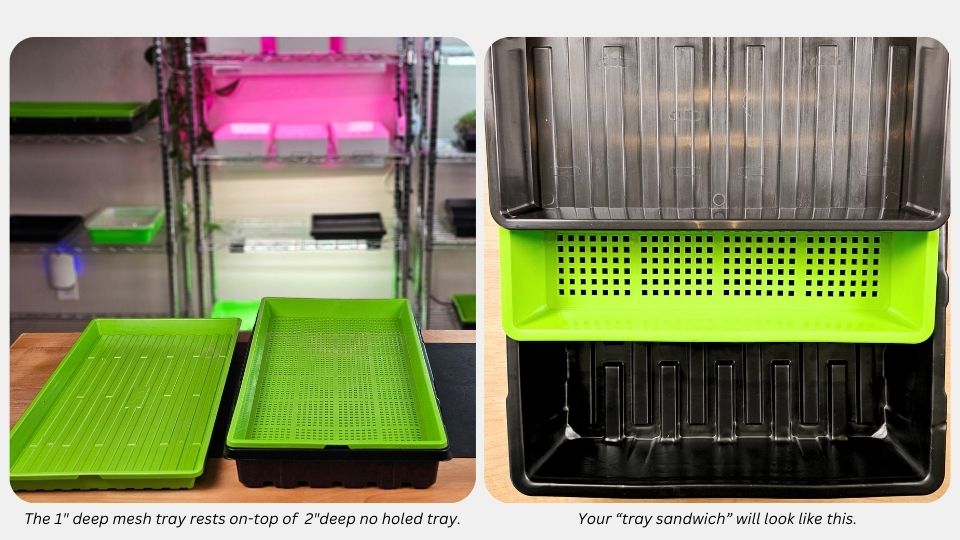
Step one; Tray Setup: Make a tray sandwich the 2-inch deep tray will be at the bottom, with the 1-inch deep mesh tray resting ontop of it. Set aside the 1-inch deep no holed tray for now.
Step two; Grow Medium & Labeling: Once the trays are setup, we place one sheet of our Silicone Reusable Grow Medium onto the mesh tray. Now we're ready to seed the medium. This next step is optional, however, we attach one of our patent-pending tray clip labelers to the tray so that we can write which crop we are growing and the date we started the tray.
Step three; Seeding & Watering: Seed the medium with your seed of choice, we're using broccoli microgreen seeds for this grow. Since it's a 10x20 tray, we'll be using the suggested amount of seed from our Free Tray Specific Microgreen Seeding Guide PDF for the tray size. Once the medium is seeded, we give the seeds a good mist with regular water, making sure they look nice and moist.
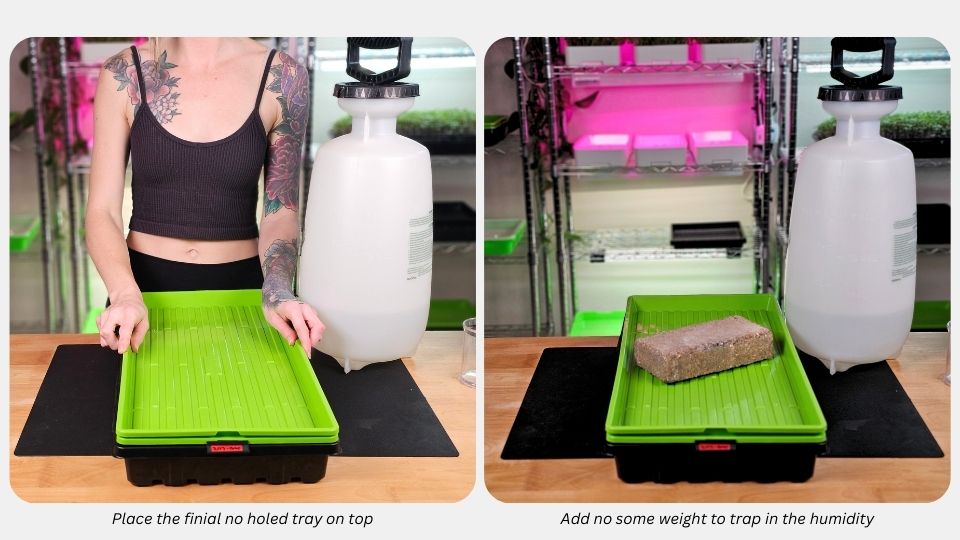
Step four; Trapping in Humidity & Germination: Now take the remaining no-holed 1-inch tray and place on top of the seeds to trap in the humidity. You can also add some weight if you'd like, however with this setup be cautious not to add to much weight or it will cause the tray to bow in the middle, and can also cause poor germination. In most cases, its better to use no weight for this method.
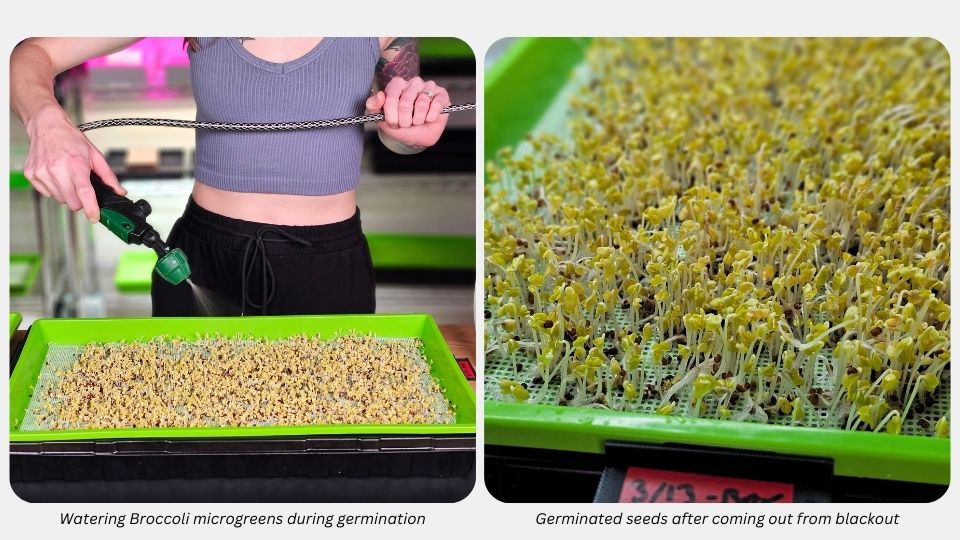
Germination Continued: Going forward, you will mist 1 to 2 times per day with regular water, until your crops look like they are ready to transition from being under weight and into blackout. If your curious to learn how to identify their readiness at a glance, be sure to read our blog "Unlocking the Secret: Knowing the Right Time to Transition Microgreen Trays from Weight to Blackout" , typically, for most varieties this process takes 3 to 4 days total. After you are through the germination phases of being under weight & 24 hours of blackout, you are ready for the final steps.
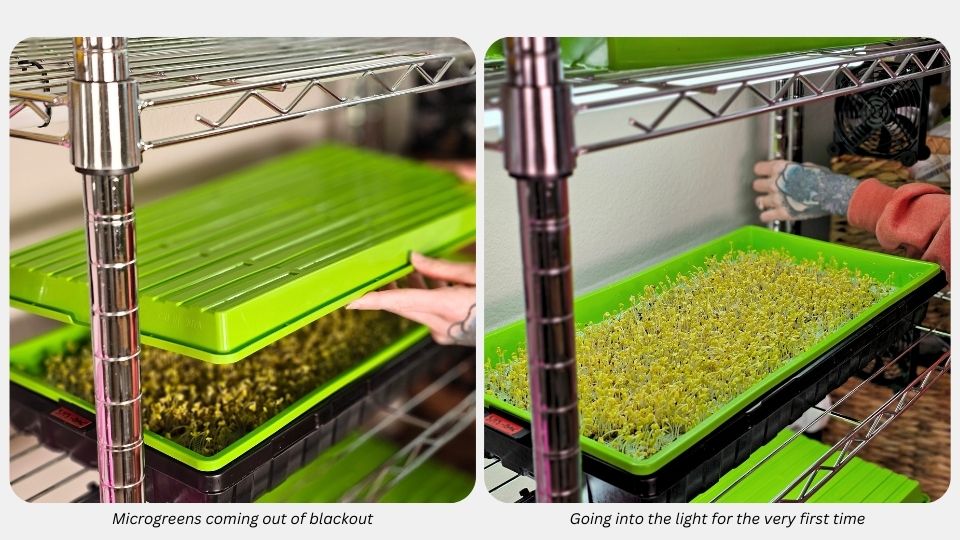
Step five; Into the light: At this point in your Microgreen grow, you are finished with the initial germination and it's now time to introduce them to light for the very first time. We're using a smaller home grow rack setup with two 2ft LED lights per shelf as our light source in the photos.
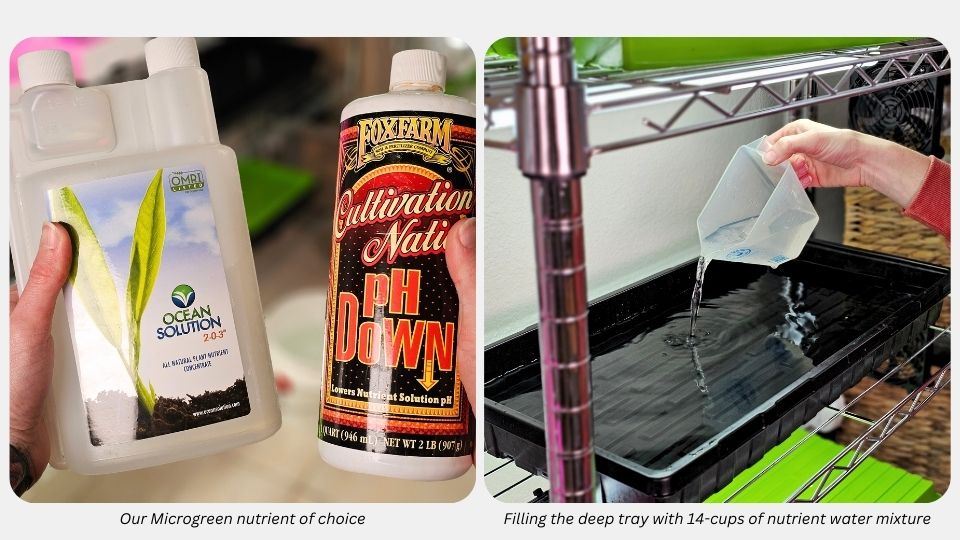
Step six; Filling the Kratky reservoir and (optional) adding nutrients to water: In a separate 3-gallon bucket we fill it with filtered tap water, then mix 1.5ozs of Ocean Solution 2-0-3 organic fertilizer (0.5oz per gallon of water), then pH balance to the 5.5-6.0 range. You don't have to use the same fertilizer that we do, and if your curious what other options there are for microgreens, we highly suggest reading our blog "Top 8 Hydroponic Nutrients & Garden Fertilizers". Once your nutrient water is mixed and ready for use, fill the 2-inch deep reservoir tray with 14-cups of the mixture, leaving roughly an 1 to 2 inches from the top of the tray empty. This is so the roots have some breathing room.

Step seven; Root drip test: After filling the reservoir tray, check that all your roots are making contact with the water by lifting and tilting the tray back, as if to bottom water. You should see water droplets coming off all of the roots. Otherwise, add a little more water. This step is vital to you having a sucessful grow. If your roots are not making contact, they will dry up, and cause your microgreens to die off.
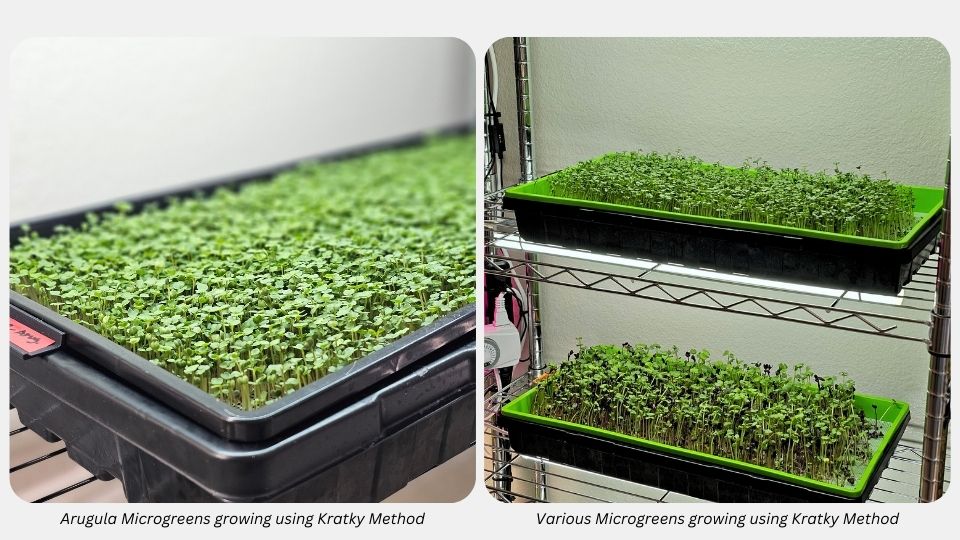
Step eight; the easy part: Once you have confirmed your roots are touching the water, everything is now passive and you literally have nothing to do for a few days! We like to check-in to see where the microgreens are at in growth, and if we need to top off the water. For most crops, we've found that we can make it all the way to harvest day without filling up again, typically 4 to 8 days. However, this part really depends on the crop you are growing, as well as your grow enviroment, so be sure to do your own tests to learn the timing for you before steping out. Once you see the development of trueleves on your canopy, it's time to harvest you microgreens!
Videos on Utilizing the Kratky Method
At this current time we are working to bring new YouTube videos to our channel on how to grow microgreens using the kratky method, however, we have a series already avaible on TikTok that showcases how we grow using this setup.
Conclusion
The Kratky method offers an excellent solution for those looking for an easy-care gardening method while also cutting down the expenses associated with automated systems. It serves as a fantastic entry point into more sustainable growing practices, particularly through its efficient water use and the incorporation of our reusable grow medium. However, other mediums can be used in its place.
We hope that this blog gave you enough guidance to start growing Microgreens using the kratky method so that you can step-out for a weekend getaway or overnight trip this summer, while returning to abundant trays.

Great article. It confirms that what I have been doing is correct and I am on the right track. Great explanation with clear step-by-step photos. I use the reusable grow medium with your trays and I always get excellent harvest 😊